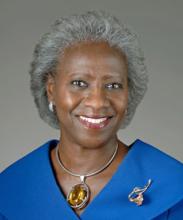
March, 2020
DR. VALANTINE'S FOOD FOR THOUGHT

Hannah A. Valantine, MD Chief Officer for Scientific Workforce Diversity
This month offered a wealth of contributions from magnanimous women forging scientific history in many fields. In honor of the occasion, this issue will take a forward-looking approach, highlighting our current history makers, signs of progress, and groundbreaking solutions designed to address challenges in the path to gender equity in the scientific workforce.
The Pipeline Continues to Pump
Recent data from the Survey of Earned doctorates shows continual progress is being made in the realm of gender equity in the scientific workforce. While large gaps in overall trends for PhDs in Science and Engineering show disparities (24,283 male recipients vs 17,924 female recipients), the life sciences appear to be more equitable (5,659 male recipients vs 7,114 female recipients). Additionally, the number of women PhDs has kept pace with previous years trends in the life sciences, increasing by 14.6% compared to 2009. Of the female PhD recipients in all fields with definite postgraduation plans in 2018 (15,525), 38.6% had plans to pursue postdoctoral research. The successful transition of a major portion of women PhD recipients further underscores the growing pool of female candidates to enhance diversify of the US professoriate.
The Path to Evaluating STEM Fellowship Applicants More Equitably
Astronomy, like many scientific fields, struggles with challenges related to gender equity. The prestigious Pegasi b Fellowship supports early career astronomers, but until recently primarily awarded male astronomers—that changed in 2019, when women won four of six fellowships. Dr. Joyce Yen took the lead of the program that year, and the transformation is the subject of a recently published a Nature Astronomy commentary article. She detailed how fellowship evaluation processes can mitigate biases and be more welcoming to female scientists, by using social science research ideas to tweak review methods, including (but not limited to): revising application processes—open to all eligible applicants (instead of nominations from universities), including a Diversity, Equity, and Inclusion statement to be evaluated as part of the application, and re-aligning deadlines to those used by most of the field. As Dr. Yen argues, this work is important because fellowships are mechanisms to recognize rising stars, which serve as gateways to faculty positions—a critical place for interrupting bias.
Future Leaders: Putting a Face to Success
Women’s history is rich with individuals from diverse backgrounds in the scientific workforce, including many researchers who are shaping history, today, here at NIH. Dr. Kizzmekia Corbett is a prominent figure recently highlighted in the New York Times; she has contributed her virology training to be the scientific lead of NIH’s effort in developing a vaccine against the new coronavirus. Dr. Yeka Aponte is one of NIH’s prestigious Stadtman Investigators and a tenure-track investigator at NIDA; she uses advanced neurobiological techniques to answer important research questions related to the neural connections driving addiction and overeating. Dr. Lorna Role, recently appointed as scientific director at NINDS (and one of few women holding the position), has kept an eye towards the importance of diversity by purposefully selecting her introductory committee members based on a balance of diverse expertise and experiences; she is also continuing her research on cholinergic signaling—important for attention and memory. Dr. Michelle Jones-London has been a NIH leader in the realm of scientific workforce diversity for over a decade. She directs the Office of Programs to Enhance Neuroscience Workforce Diversity which includes a host of training and outreach programs designed to spurn the next generation of scientists.
A Behavioral Approach to Gender Inequality
A London School of Economics and Political Science article argues for leveraging behavioral science to address gender inequality at companies, but the advice may also offer insights for institutions hiring professorial talent. The suggestions lean on the work of gender equality research hubs, noting gender inequity as an innovation problem that requires experimentation and applied behavioral insight. A select list of the takeaways related to the Gender Pay Gap could be applied to address broader equity goals, during professorial recruitment: include multiple women in shortlists for recruitment and promotions; use skill-based assessment tasks in recruitment; adopt structured interviews for recruitment and promotions; encourage salary negotiation by showing salary ranges; introduce transparency to promotion, pay and reward processes, and appoint diversity managers (with executive-level authority) and/or diversity task forces. With appropriate considerations, the application of these ideas could drive change related to gender inequity in the professoriate.

The links above are pulled from the top news articles trending on the subject of diversity in science and technology.
The stories selected are not a reflection of the views of the National Institutes of Health.

